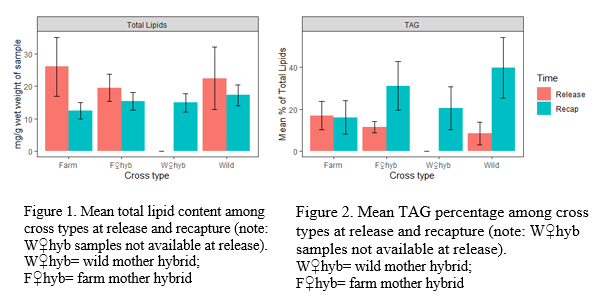DIFFERENCES IN LIPID AND FATTY ACID ACQUISITION AND STORAGE OF FARM, WILD, AND HYBRID ATLANTIC SALMON Salmo salar COMPETING IN THE WILD
Farmed Atlantic salmon have experienced multiple generations of both intentional and unintentional domestication selection, generally reducing their fitness in the wild. When farmed salmon escape and interbreed with wild populations, these differences can lower wild population productivity and alter key life history traits. Understanding the genetic basis of fitness-related traits of farm, wild, and hybrid salmon is critical to predicting population impacts from farm escapees. To date, only a few European studies have considered all cross-types under common conditions in the wild, and none have examined lipid and fatty acid content, which are key influencers of fish health and performance. As such, this study used lipid and fatty acid analyses to investigate differences in energy acquisition and storage among experimentally derived Atlantic salmon fry from four cross-types (wild, farmed, and reciprocal F1 hybrids) during the first summer of growth in a southern Newfoundland river.
Wild-mother hybrids and pure wild fish had the highest recapture numbers, followed by pure farm fish, and then farm-mother hybrids. There was little effect of cross type on total lipid content at both release and recapture (Figure 1), however overall lipid and fatty acid profiles differed among cross types at both time points. Farm fish were the most differentiated cross type at recapture, with low levels of triacylglycerols (TAG) (Figure 2) and certain fatty acids indicative of freshwater prey suggesting a feeding disadvantage in the wild. Overall, the data indicate potential differences in foraging ability and/or energy storage among cross types, thereby improving our understanding of differential growth and survival.
